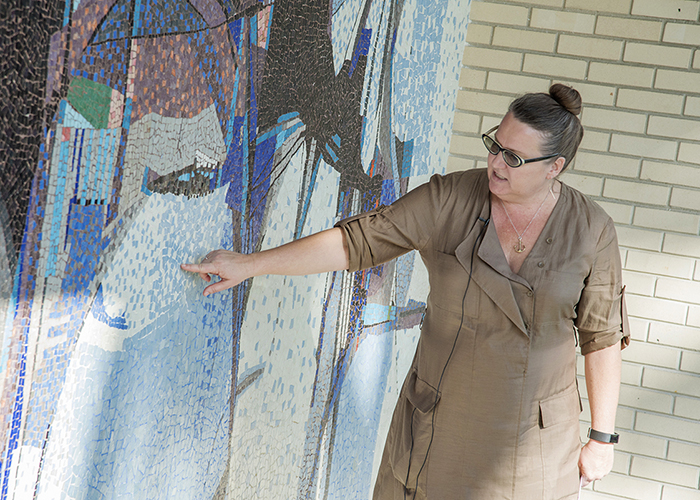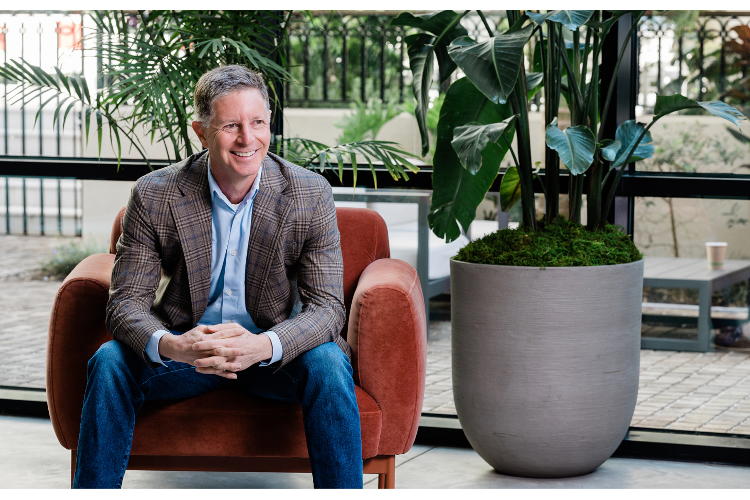10 things that may surprise you about USF
Did you know that you, your friends and anyone else can access many classes and services provided at the University of South Florida? Learn how and where.
As a higher learning institution, you might think the University of South Florida is strictly for the 18- to 20-something set, its faculty, and staff. But the university opens its campuses and reaches out to other learners in the Tampa Bay Area community as well.
To help you discover just what we’re talking about, 83 Degrees Media offers a sample list of 10 lesser-known facts about USF and how it serves the broader community in Tampa, St. Petersburg, Sarasota, and nearby communities. Some of them may surprise you!
1. Kids can take swimming lessons at USF’s indoor pool
While it’s true the indoor swimming pool at USF in Tampa is part of Campus Recreation, and is intended to serve the USF community, the public can use it, says Benjamin Pazian, USF’s Aquatics Coordinator and Head Swim Club Coach. “Our biggest

focus overall is safety, and trying to provide our patrons in the community with as many offerings as possible at a low, reasonable cost,” he explains.
That’s a real plus in an area where outdoor pools are more common, and pretty much off limits when temperatures dip. USF’s indoor pool is open year-round and teaches swimming lessons in the summer to infants as young as three months old (with a guardian).
USF offers an American Disabilities Act chair at the indoor pool and a special entry ramp for the physically disabled at its new outdoor pool in The Village.
It is planning to hone in special needs offering services free or at minimal cost to reach as many people as possible. “We’re not trying to pull pennies out of people. We’re just trying to provide people with good aquatics programs and service that improve overall experience around pools,” Pazian says.
While special rates apply to students and others associated with USF, a day rate of $15 is available to the public. Membership services also may be able to arrange a workaround so you can join, even if you attended college elsewhere. You can reach them by calling 813-974-7084.
Learn more about private swimming lessons for all ages, and about rates and hours
“All of our pools are heated,” he says. “If the gym is open, we’re open.”
2. You can tee off at USF’s golf course
Avid golfers can pay quite a bit to play their sport. At The Claw at USF, the university’s golf course at 13801 N. 46th St., Tampa, golfers pay $10 at specified times when they book online. “We are open to the public with additional discounts for USF students, faculty and staff, and Alumni Association members,” says General Manager Kandace Clatterbaugh.
The 18-hole, par 71 course, considered one of the area’s most challenging public courses, features long, tight fairways. It got its name from a tree at hole 14 that was “roughly 100 feet high and had branches that resembled a claw,” Clatterbaugh says.
Check out the golfing details.
3. High achievers may be able to start college early; it’s even tuition-free for the first year
An early admission program by the USF Honors College allows some students who have completed six semesters of high school to start college early, with their first year’s tuition paid by their school district (or waived in the case of private school students). The program falls under the state’s Dual Enrollment program, which establishes funding.
“USF is one of several post-secondary institutions that offer this full-time dual enrollment option for eligible students,” says Arnaldo Mejias, Coordinator of Dual Enrollment and Early Admission at the Honors College.
The Honors College, which offers a learning experience tailored for high achievers, usually averages about 10 public, private and home-schooled students in this special cohort. They take courses that meet both high school and college requirements. The students are still charged some fees; they may be offered Financial Aid for subsequent years at USF.
“Participants benefit in many ways: students earn college credits applicable here or elsewhere, they experience university life, and often engage in faculty-mentored research,” Mejias adds. “Interested students learn of these opportunities through district communication, a school guidance counselor, or by visiting our website.”
4. Seniors (those 60 and up) can attend for free
OK, so life got in the way. You wanted to go back to school — and now quite a few years have passed. You may wonder if you’re up to the routine of those 18 to 20-somethings in the USF classrooms. Not to worry. Senior Florida residents who are 60 years old or older, that is — can audit some undergraduate and graduate classes on a space available basis, for free. But it’s on you to get the waiver and permission to take the class or classes you’d like by the deadline, so plan ahead. You won’t be exempt from state immunization requirements, so you’ll need to plan for that also if you’ll be attending classes on campus. Learn more.
5. Over 50? You can network and expand your connections
You may be remembering fondly the blast you had during college. Wouldn’t it be great to enjoy the social life minus the tests, term papers, and grades? The Osher Lifelong Learning Institute, or OLLI-USF, lets people 50 and over continue their education while enjoying some social perks. There are no tests or grades. Most of the courses don’t require pre-requisites either.
The membership program offers more than 300 classes annually to its members; most of the teachers are members themselves. Learn technology (courses range from beginner to advanced for both MAC and PC users), science or nature, politics and current events, literature and writing, lifestyle and fitness, humanities and the arts, and history.
Meet people who share your enthusiasm about genealogy, hiking, photography, the mountain dulcimer and more through Special Interest Groups that are free to members. In addition to OLLI socials, there are some special programs and events open to the general public.
Annual membership is $40; join for three years for $100. Learn more about Lifelong Learning.
6. Anyone can take a free public art tour
Heads up, art buffs! There’s quite a public art collection at USF and free public tours are available. Parking fees apply.
“I don’t know that many people know that it’s an option,” says Sarah Howard, Curator of Public Art and Social Practice.

There are about 125 works, 34 of them highlighted on a map available online.
One of the more notable works is Solar Rotary by Nancy Holt, a work dating back to 1995 that was funded by Florida’s Art in State Buildings Program. The now-defunct Tampa Tribune also contributed funds for the project.
“It’s one of the gems of our collection,” Howard says of the art located in the Communication and Information Sciences Building Courtyard. “The design of this piece is very site-specific and really responds to the history of Florida and to the history of the university.”
It functions as a timepiece, casting a shadow that rotates around the plaza where it is located. During the summer solstice, the shadows highlight a bench in the center.
Howard usually does six to eight sites during a walking tour, which may take an hour and a half. “We actually commission a lot of these pieces,” she says.
The university was recognized as one of the 10 best art on campus selections in America in 2006 by Public Art Review, based on responses from Public Art Network subscribers, she adds.
The famous artist Pablo Picasso even envisioned one of the world’s tallest sculptures entitled “Bust of a Woman,” for USF in Tampa before he died in 1973. The vision called for a 100-foot, reinforced concrete sculpture to include an art center designed by world-famous architect Paul Rudolph. The project was never funded, however.
Howard has a model of the sculpture on her desk. “The Picasso story is a fun story, but it didn’t happen,” she says. “It’s kind of one of the mythological things.”
Check out the public art program, which has work on all three USF campuses in Tampa, St. Petersburg and Sarasota.
7. The library is open to the public
You might believe the USF Library in Tampa is off limits to non-students and non-staff. Not so. The library also is open to alumni and the community. Check-out privileges are available to Alumni Association members; others can purchase Special Borrowers’ cards for $50. If you are part of an organization affiliated with USF, such as International Baccalaureate programs, other state universities, Moffitt Cancer Center or Patel Charter School, you should check with the Library Service Desk about privileges you may have through service agreements.
The library additionally is committed to providing services to the disabled and offers accessible parking for the physically challenged. It has text magnifiers, a Braille printer, and Duxbury Braille printing software in the Learning Commons area.
Learn more about the library.
8. Visually impaired? USF is using an innovative way to help
Navigating a large campus like USF in Tampa without sight can be especially challenging, but help is on the way. USF is planning to use innovative tactile maps to assist the visually impaired starting in the spring next year. They’ll be posted outside classrooms, next to room numbers already marked in Braille.
The USF Advanced Visualization Center has been developing tactile versions of maps marking emergency exit routes, which are printed on plastic material with a 3D printer. They include vital information like whether the classroom has steps, whether the doors are pushed or pulled, and where emergency exits are located.
Howard Kaplan, visualization specialist of the AVC, began testing with five students last summer. He’s also working with Tampa Lighthouse for the Blind and the U.S. Department of Veterans Affairs, in the hopes of someday making maps like these available worldwide in public spaces.
Learn more in this 83 Degrees story.
9. Need a costume for a special party? Shop at USF
If you’re looking for a really cool costume for a masked ball or themed party — or even costumes for your local theatre group’s next production — watch for periodic public costume sales held by USF’s School of Theatre and Dance and College of The Arts. USF clears out clothes and accessories from past productions in different styles from different time periods. Got questions? Check out and follow their Facebook page.
10. Why Rocky? Learn about USF mascot
Maybe you’ve wondered about the USF mascot: How was Rocky the Bull chosen? Here’s what we learned from a 1989 account in The Oracle student newspaper by Patricia Abdou.
In USF’s early years, chickens, roosters, camels and desert rats all had a shot at becoming the mascot. The Golden Brahman was chosen from among five finalists, including the Buccaneer, the Olympian, the Cougar, and the Golden Eagle, even though it took a close second place. There were concerns the first-place Buccaneer was already in use. When it was learned Buccaneer was available, debate followed until a run-off election led to the Golden Brahman’s selection in 1962. The Brahman was fitting, as Florida was a cattle-raising state, and it remained in use until the 1980s, when it was changed to the Bulls for promotional reasons.
According to the USF website, Rocky dates back to 1974 and has undergone some redesigns since. You’ll see him at athletic games and community events, where he’ll happily pose for a selfie if you ask nicely.
















